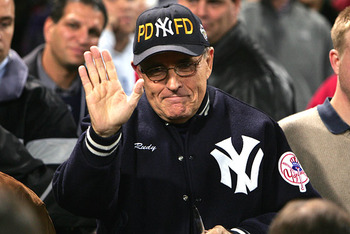|
The aggressive swarm of Seattle Seahawks reminded me of a young HC of the NYJ.
Not Bill Belichick, but Pete Carroll. Carroll was the new head coach in 1994. He had an outdoor basket put up in the Jets’ bunker, on the theory that team members might enjoy shooting hoops in their spare time. Some football people snickered at this unorthodox maybe-Left-Coast way of doing things. The Jets went 6-10 and Carroll was fired by the owner, Leon Hess, the oil man who used to tell a Times reporter to please not write that Hess had visited Jets’ camp because he was supposed to be in the office. Carroll later coached the Patriots and won a national title at Southern California, where he ran around at night with youth gangs, urging members not to tear up their world. Now the Seahawks have humbled the Broncos, showing not only speed and power but also the flexibility to make big plays. They could react, not just follow orders. I thought about the outdoor basket at the Jets’ bunker, and the new coach who had a somewhat different way of doing things. * * * There was another moral to the Super Bowl. The NFL tempted fate by putting a Super Bowl in a northern clime, in what is turning out to be a nasty winter. Some gloom-and-doom types, no names mentioned, forecast a blizzard. But the Giants built pro football in New York by selling a few hundred extra tickets on Sunday mornings when rain or snow or chill somehow dissipated and people felt like going out to watch a game. In New York, this glorious tradition is known as Mara Weather, after the family that still owns half the team. The Super Bowl was played on an early November or early April day. Mara Weather. Never, ever, forget it. What an odd sport, American football. Here was a man about to score a touchdown in the final minute of the Super Bowl, yet trying to erase a lifetime of muscle memory for lugging the ball into the end zone.
Ahmad Bradshaw of the Giants was trying to halt his large, mobile body at the 1-yard line but he just couldn’t get himself down. A man could blow out two knees or maybe a spinal column doing that. That was the strategy after more than three hours of ominous commercials and hard play: the Giants wanted to kill some seconds before Tom Brady got the ball again. But Bradshaw could not put the brakes on his forward momentum, so the poor feller had to settle for a touchdown with 57 seconds left that ultimately won Super Bowl XXXXVI, 21-17, over the Patriots. Congratulations to the Giants’ owners who showed their traditional patience with Coach Tom Coughlin during a disappointing autumn, and condolences to the Kraft family. And the one dominating memory of this game -- in a sport that preaches going all out -- is likely to be a running back trying to plop his body down short of the goal line. Very strange. The Chelsea-Manchester United match from frigid London put us in the mood for a taste of home.
We drove out to to the House of Dosas in the Indian enclave in Hicksville. Nobody was wearing Giant or Patriot gear. My wife waved at a little girl at the next table. She waved back, with a gold bracelet glittering on her tiny wrist. We had bhel puri, eggplant curry and rice, plus poori and potato masala, and my wife had spiced tea afterward. The waiter confided that they had just sent out for their own lunch – pizza, for a change of pace, he said with a laugh. We were now fortified for the long evening ahead. What a country. Wouldn't you know it. Old Flappy Hands made two sensational saves in the final minutes as Manchester United stormed back for a 3-3 draw after falling behind by three goals.
Love them or hate them, the Manchester United players are savage and relentness. Wayne Rooney absolutely had to take both penalty kicks. In the middle of the rally was old Giggsy, Ryan Giggs, 38, oldest man in the match, keeping up with players more than a decade younger. And old Scholesy, Paul Scholes, 37, back from retirement, reminding the new boys how Man U never gives up. What a show. Thank you, Fox. And all this action in less than two hours. Good luck to American football later on. Best broadcaster call of the day may have happened already, in Real Football.
In the pre-game show before Chelsea-Manchester United on Fox, Eric Wynalda called Man U's David de Gea the worst keeper in the league, and predicted trouble for defender Jonny Evans, too. Waldo called De Gea "Old Flappy Hands." Spot on. De Gea looked sloppy in the first half, with timid punches, and culminated by tipping the ball right off Evans, ricocheting into the goal for a 1-0 halftime lead for Chelsea. Is there a more foolish display by public officials than the mandatory Super Bowl wager between mayors or governors? Are they so craven that they need the attention?
Phil Taylor of Sports Illustrated, one of the most thoughtful voices among American sports columnists, has a great point this week. He wishes politicians would butt out of sports, particularly those public figures who don’t know a thing about them. Once again, Taylor has done his homework, citing ludicrous examples of politicians who were clearly pandering, out of their element. A rare example of bipartisanship: clearly, over-reaching knows no political boundary. Yet my home town of New York has had two recent mayors who took diametrically opposite positions toward sports, and both worked, for them. Rudy Giuliani made no secret of rooting for his Yankees, whereas Ed Koch had a visceral disinterest in anything sporty. Giuliani wore his Yankee jacket and cap, was a frequent visitor to the Stadium, knew the players, and knew the game. He was delighted that his position as mayor could get him up close to the field. The Yankees won five pennants and four World Series during his regime. He showed up for the sixth game in Arizona in early November of 2001. Given what he had been through back home in the two previous months, he had every right to follow his team. The next morning he was back in New York at the start of the Marathon – another statement that the city would endure, that nihilists and lunatics could not shut us down. Then he flew back to Phoenix for the seventh game that night. “You’re sick,” I said to him in the crush of the deflated clubhouse after the loss. Giuliani understands clubhouse talk. He smiled and shrugged. It was his team, and he was there, to whisper support to Mariano Rivera, to praise the winning team. “''I appreciate the way we were treated,'' Giuliani said. ''And if you have to lose, it's better to lose to a city like this. These people sent us search-and-rescue crews.'' Giuliani would show up at Shea Stadium on opening days or other important moments, pay his respects to the Mets and their fans. But everybody understood. He was a Yankee fan. He had earned that right. Rudy Giuliani was never more appealing than when he rooted for his team. Koch could care less, as we say in New York. He had no interest in sports. If his top aides say, Mr. Mayor, you have to go to opening day, he would allow himself to be whisked out of Manhattan into one outer borough or another, where he would be introduced, endure the obligatory boos, and take a seat for an inning or two. Hizzoner might have stayed longer if the ballparks had included an outpost for some Peking duck emporium. But around the third inning, you would glance down at the box seats, and there would be a gap in the spectators. While the teams changed sides, the mayor had bolted for the exit; the limo was taking him back to the safety and the aromas of downtown. But he never faked it, never talked manly jock talk, never pretended to know who played first base for the Yankees or Mets. I think the estimable Phil Taylor would agree: (strictly in a sports context) if you can’t be Rudy Giuliani, then by all means be Ed Koch. And politicians: have you no dignity? Stop with the wagers. |
Categories
All
|











